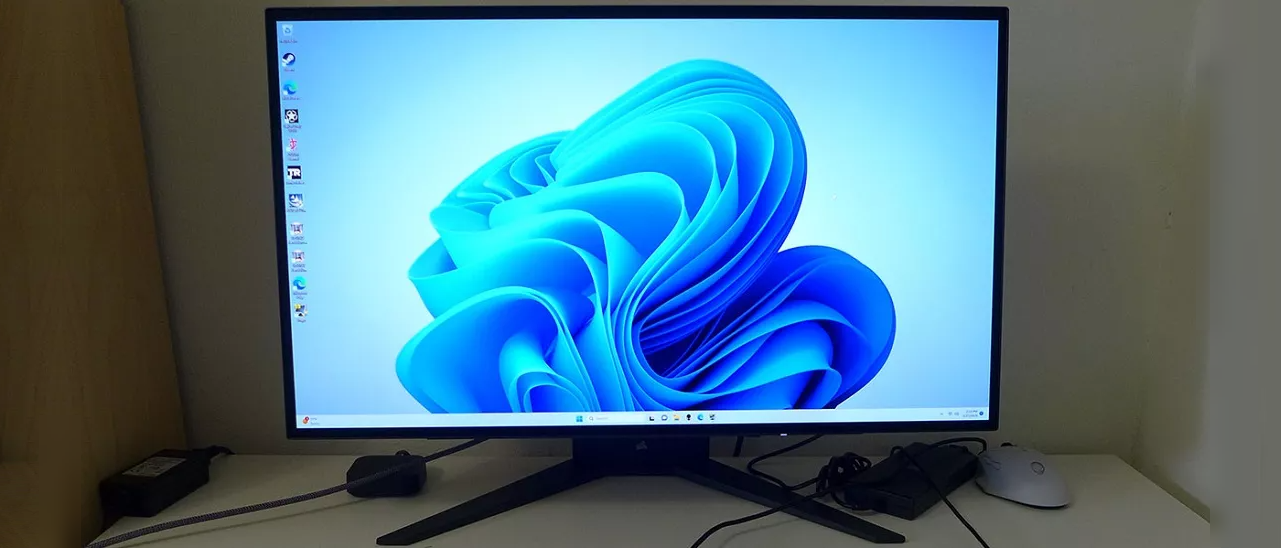Tom's Hardware Verdict
The Corsair Xeneon 27QHD240 has no real flaws. It’s expensive but given its professional-grade accuracy and phenomenal gaming performance, it’s actually a bargain. Only an equivalent OLED can match its contrast, color and video processing prowess.
Pros
- +
Stunning image with deep contrast and saturated color
- +
Near-perfect accuracy without calibration
- +
Next-level gaming performance
- +
Premium build quality
Cons
- -
A few minor HDR color errors
- -
Expensive, but not for what you get
Why you can trust Tom's Hardware
With the introduction of a 27-inch OLED panel from LG Display, it’s clear that this technology is not just for niche products. OLED is becoming more common among the best gaming monitors with richly saturated color, infinite contrast and next-level gaming performance. Panel response times are measured in hundredths of milliseconds, and there is no need for trickery like overdrive or backlight strobing.
Recently, I reviewed the first display to use this new panel, Asus’ ROG Swift PG27AQDM. Corsair’s version is called Xeneon 27QHD240, and its model designation doesn’t hint at how special this monitor is. OLED is truly on another plane above Mini LED in picture quality and gaming performance. The 27QHD240 is a QHD panel with 240 Hz, Adaptive-Sync, wide gamut color and HDR peaks of 1,000 nits. It also boasts a 0.03ms gray-to-gray response and packs it all into a solidly built display that sells for $1,000 at this writing.
Corsair Xeneon 27QHD240 Specs
| Panel Type | Organic Light-Emitting Diode (OLED) |
| Screen Size / Aspect Ratio | 27 inches / 16:9 |
| Max Resolution & Refresh Rate | 2560x1440 @ 240 Hz |
| FreeSync & G-Sync Compatible | |
| Native Color Depth & Gamut | 10-bit / DCI-P3 |
| HDR10 | |
| Response Time (GTG) | 0.03ms |
| Brightness (mfr) | 450 nits SDR |
| 1,000 nits HDR | |
| Contrast (mfr) | 1,500,000:1 |
| Speakers | or None |
| Video Inputs | 1x DisplayPort 1.4 |
| 2x HDMI 2.1, 1x USB-C | |
| Audio | 3.5mm headphone output |
| USB 3.1 | 1x up, 4x down |
| 1x USB-C | |
| Power Consumption | 30w, brightness @ 200 nits |
| Panel Dimensions | 23.8 x 17.3-21.2 x 8.8 inches |
| WxHxD w/base | (605 x 439-539 x 224mm) |
| Panel Thickness | Glass: 0.2 inch (5mm) |
| Max: 1.9 inch (47mm) | |
| Bezel Width | Top/sides: 0.35 inch (9mm) |
| Bottom: 0.43 inch (11mm) | |
| Weight | 21.8 pounds (9.9kg) |
| Warranty | 3 years |
Most of the 27QHD240’s specs are the same as the PG27AQDM, so let’s look at the few that are different. Corsair has included two HDMI 2.1 ports versus Asus’ use of HDMI 2.0. However, at QHD resolution, even at 240 Hz, you don’t need the extra bandwidth afforded by HDMI 2.1. Both panels have native 10-bit color and that is fully preserved as well.
The 27QHD240 has a handy KVM feature that adds many USB ports. There are five traditional 3.1 connections plus two USB-C ports, with one offering DisplayPort functionality. The actual DisplayPort input is version 1.4 and employs Display Stream Compression (DSC) to keep input lag low. The 27QHD240 is one of the quickest monitors I’ve tested, even compared to 360 and 500 Hz models.
The panel is certainly the star with its infinite contrast and wide gamut color. Corsair claims 98.5% coverage of DCI-P3, and I measured a hair more than that, 99.01% to be exact. And that color is as close to perfect as it gets. The 27QHD240 doesn’t need calibration, nor does it benefit from it. My sample was optimized to perfection right out of the box.
OLED contrast is legendary in that it cannot truly be measured. No instruments currently available can measure an OLED panel’s black levels. Corsair claims 1,500,000:1 for the 27QHD240, but I cannot measure that. When a pixel is black, it’s off, meaning it emits no light. It’s hard to describe what that means to picture quality other than it’s an image you won’t find anywhere else, even from the very best Mini LED panel. And no extra features are required, like dimming zones or dynamic contrast. This performance is available in both SDR and HDR modes natively.
The 27QHD240’s build quality befits its $1,000 price tag. While this puts it firmly in the premium category, it isn’t a prohibitive sum for what you get. 240 Hz means super smooth motion and gamers will find this monitor suitable for any type of play, from casual to pro-level competition. There are a few cool touches here, too, like an OSD that appears when you put your hand near the control buttons and inputs that face back rather than down for easier access. I love putting displays like this through the wringer, so let’s take a look without further ado.
Assembly and Accessories
Corsair delivers the 27QHD240 in a plain brown wrapper with the panel, stand and base packed in crumbly foam. You won’t know how special it is right away since there are no loud or colorful graphics on the box, nor does the model number indicate that it’s an OLED. When you see the super-thin panel, though, that’ll be the first clue. You can assemble everything without tools into a solid, almost monolithic package. The cable bundle includes USB-A/C and C/C, plus HDMI and DisplayPort. A slim brick functions as the power supply.
Product 360
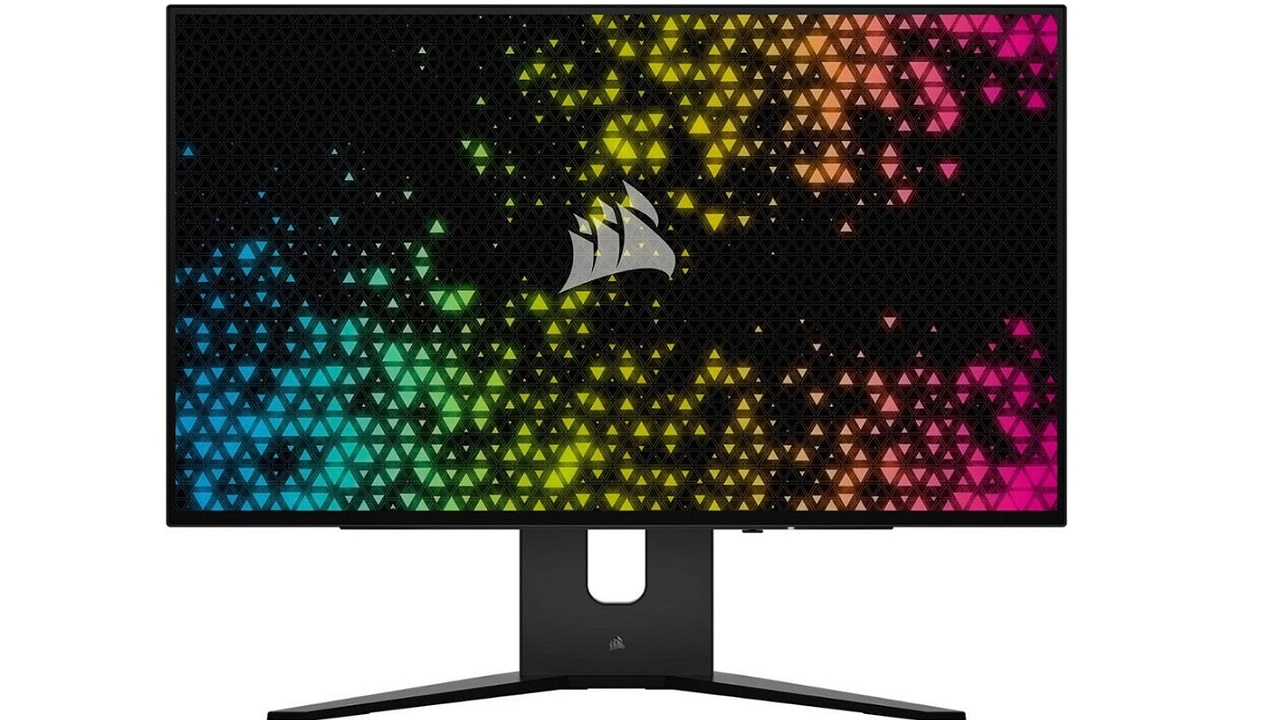
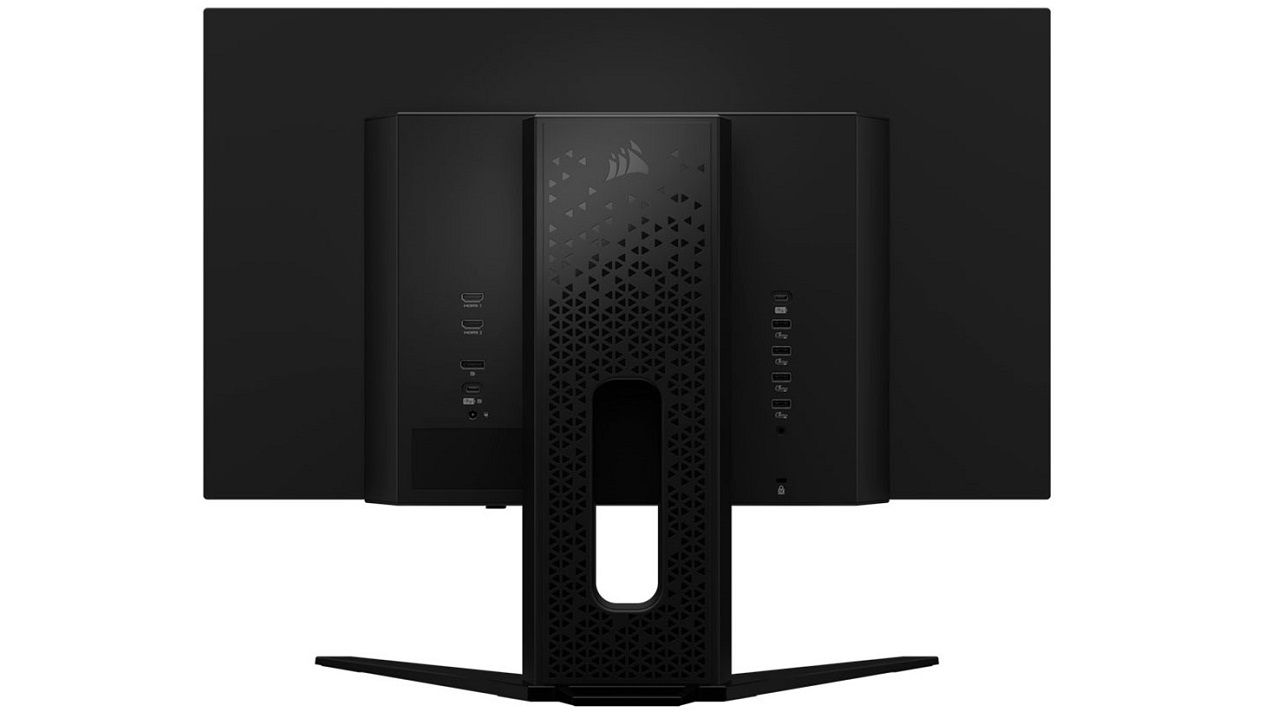
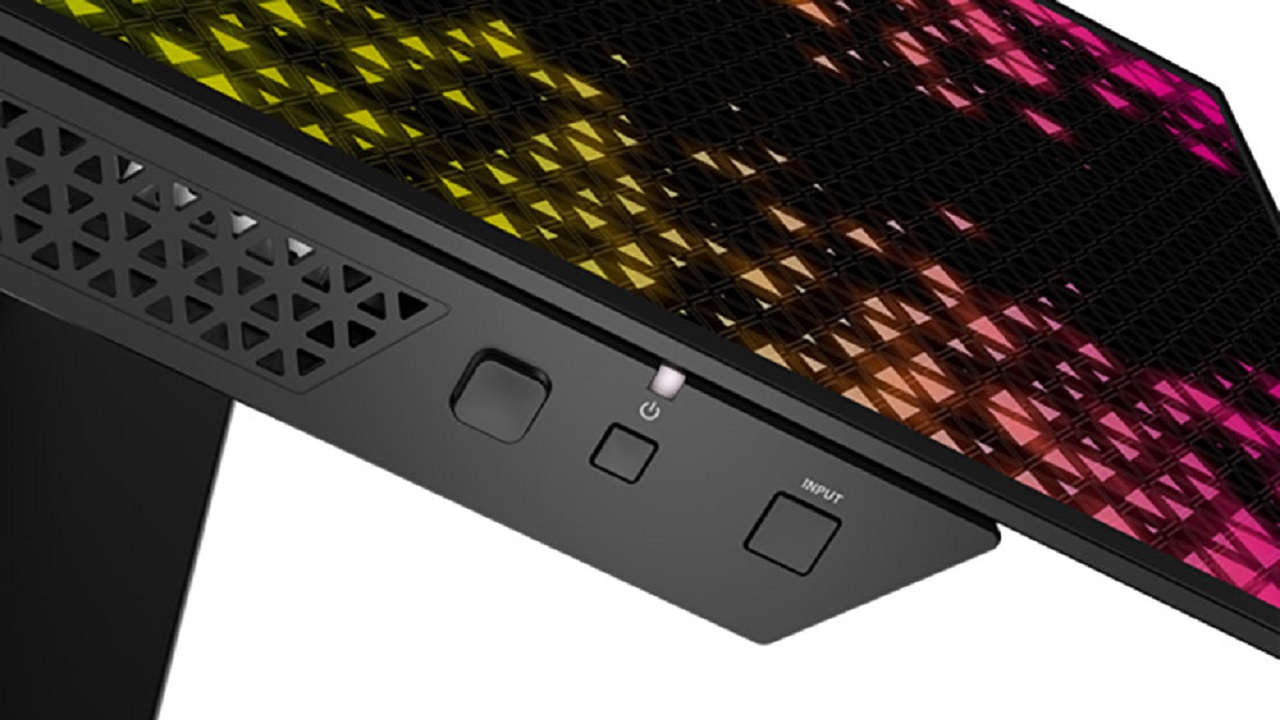

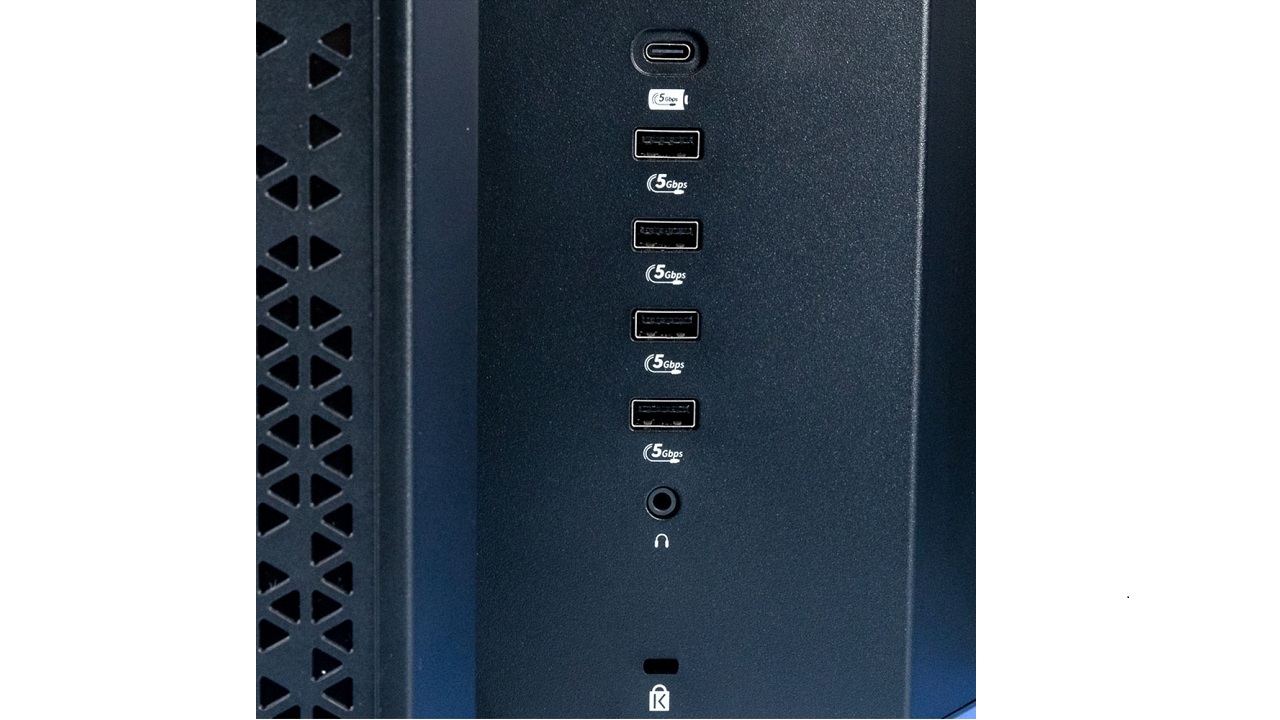

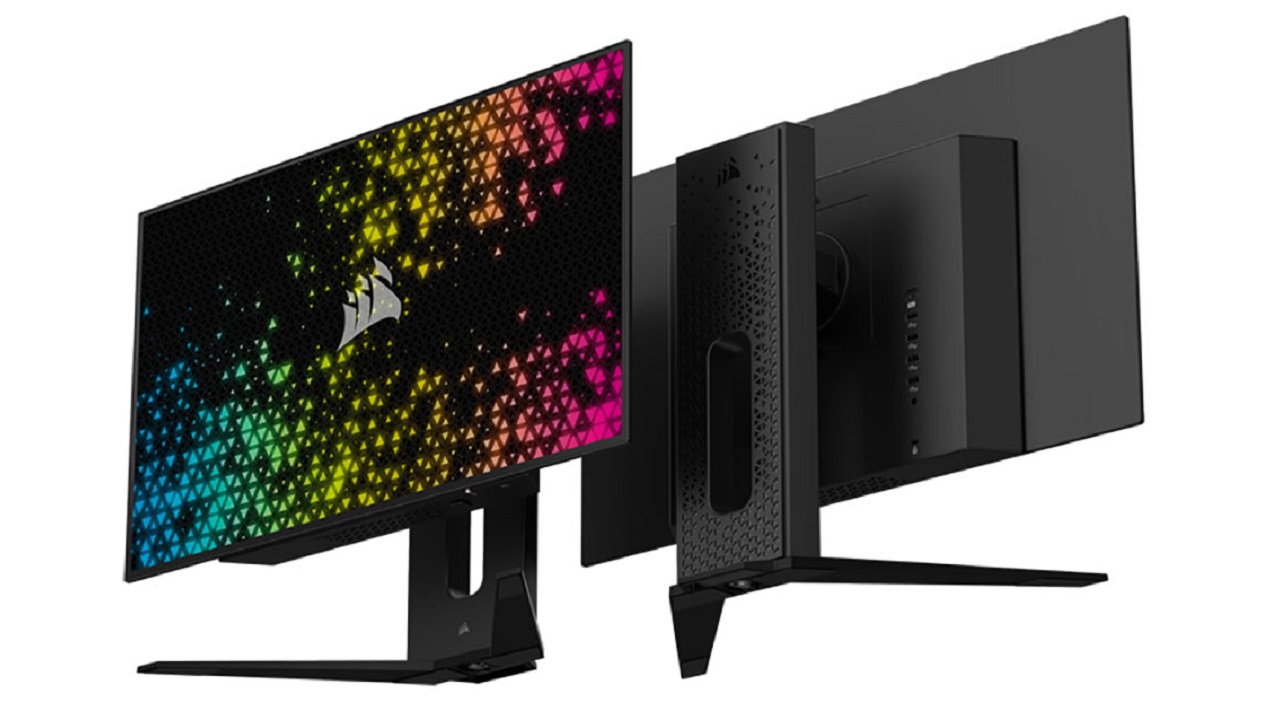
The 27QHD240 has a semi-matte screen rather than the highly reflective layer on most OLED televisions. There is no downside to this approach. I saw no grain or other artifacts. The image is crystal clear in every respect. The bezel is flush and very thin at 9mm wide at the top and sides and 11mm at the bottom. Controls are underneath, just right of center. When you reach for them, a small menu pops up telling you the function of the two keys and joystick.
Being a 27-inch QHD screen with 109ppi pixel density, the dot structure is visible if you sit closer than two feet away. It’s not 4K, but the difference is slight in a side-by-side comparison, and when there’s any sort of motion, the high refresh rate and super quick panel response ensure a perfectly smooth image.
The side view shows how thin the actual panel is, just five millimeters. A component bulge takes the total depth to 47mm, just under two inches. A 100mm VESA mount hides under the stand’s attachment point with fasteners included for use with aftermarket arms and brackets.
The stand is quite substantial, with a wide upright and deep metal base. The height adjustment is 100mm (3.9 inches) and you get 7/15 degrees tilt, 30 degrees swivel and a 90-degree portrait mode. Movement and build quality are appropriate for a monitor in this price category. You’ll be using your 27QHD240 for many years.
On either side of the upright in the back are numerous connections. On the left side are two HDMI 2.1, one DisplayPort 1.4 and a USB-C that functions as a DisplayPort input. The power supply connects at the bottom of this bank. On the right side is another USB-C for peripherals and charging along with four USB 3.1 downstream ports. The jack panel is finished off with a 3.5mm audio output. There is no internal audio, so use this to plug in headphones or powered speakers.
OSD Features
When you reach for the 27QHD240’s control keys, a small menu indicates the functions and locations of the two buttons and the joystick. This is something I have not seen before. Pressing the joystick brings up Corsair’s simple and intuitive text-based OSD.

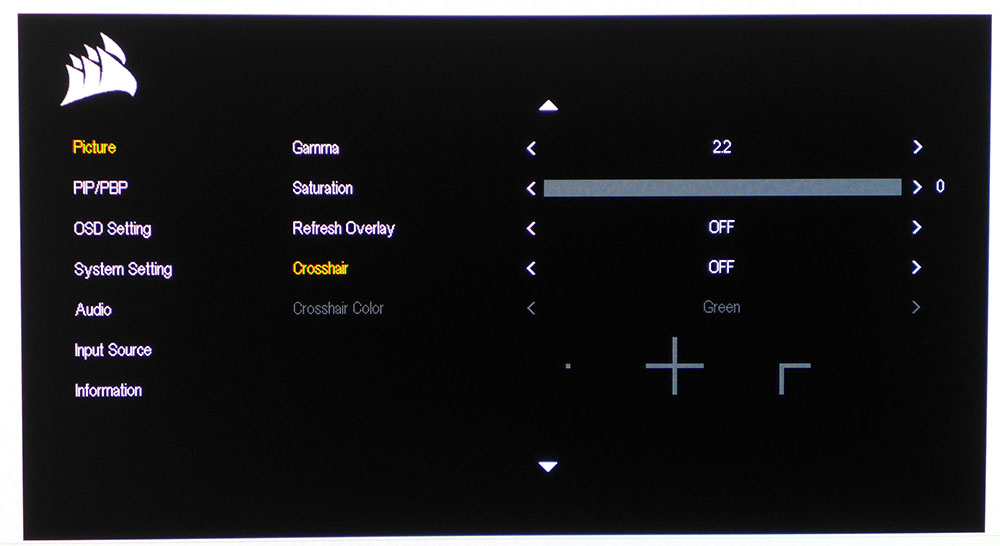
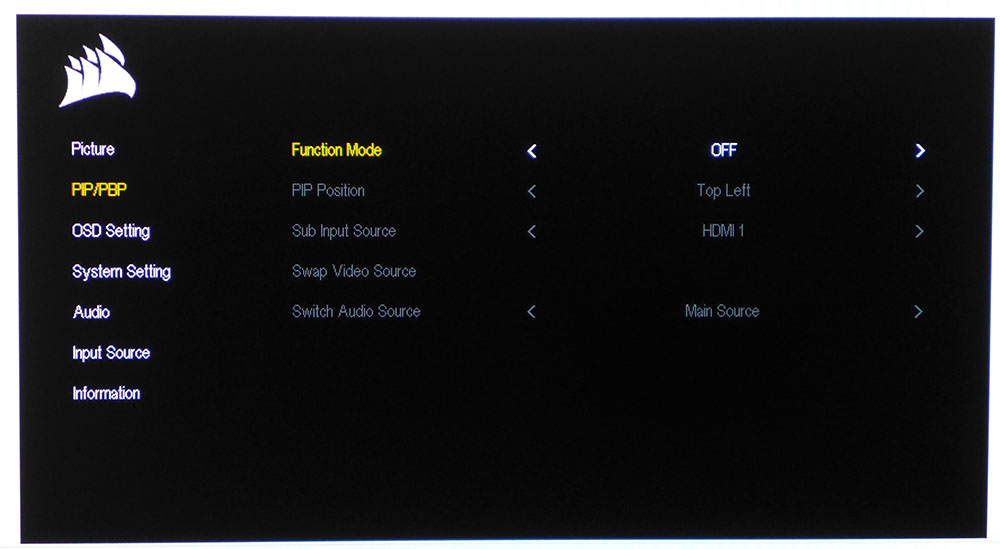
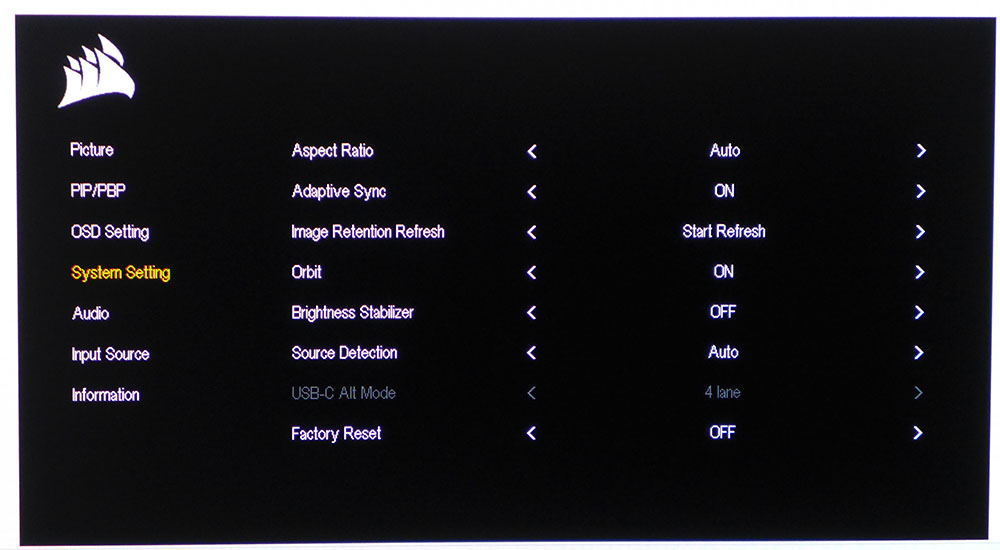
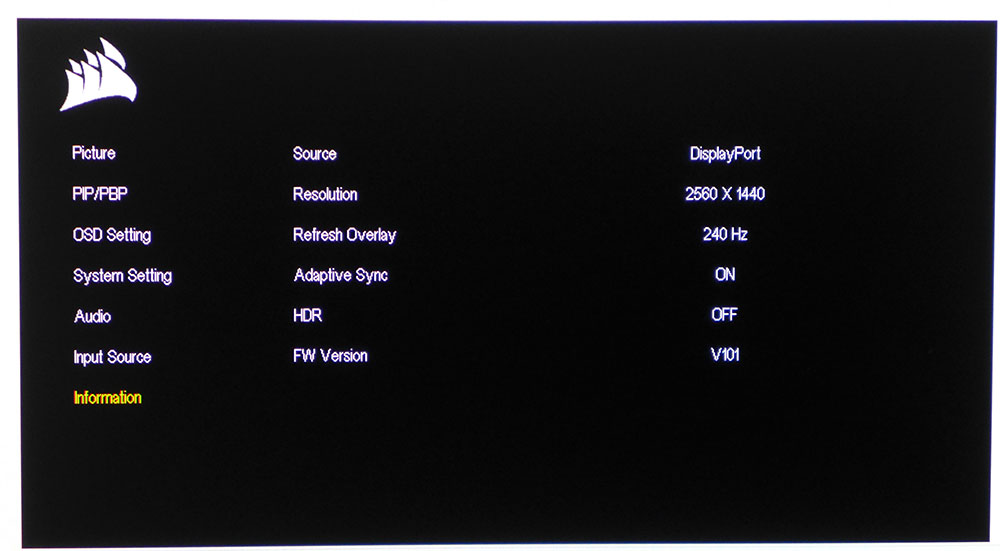
The 27QHD240’s OSD is divided into six logically arranged sub-menus starting with Picture. There, you’ll find a full set of calibration options and six image modes. Standard is fully adjustable and employs the native color gamut, which covers almost 100% of DCI-P3. An sRGB mode is also tweakable and has independent color temp and gamma options. This is a rarity, even among pro monitors. I was able to calibrate both gamuts and just switch modes when necessary. HDR signals engage an additional mode that cannot be adjusted. Additional picture options include a refresh rate indicator and aiming points which can be customized for color and shape.
The 27QHD240 has PIP and PBP that let you view two video sources, either side by side or windowed. In System Setting, you can toggle Adaptive-Sync and engage panel maintenance features like a pixel refresh and an orbiter. These operate in the background or when the monitor is in standby mode, and are designed to reduce the effects of image retention. In my own experience, I have not seen any issues with my two-year-old LG television, which is used every day.
Corsair Xeneon 27QHD240 Calibration Settings
Not only does the 27QHD240 not require calibration, but I was also unable to affect any improvement when I set up both DCI-P3 and sRGB picture modes. You can use Standard for the wider gamut in SDR mode along with the Standard color temp and 2.2 gamma for near-perfect accuracy. The User color temp has precise RGB sliders, which will improve the numbers slightly but not the visuals. If you want to use sRGB color for SDR, that mode is very accurate as well. And you can calibrate the color temp separately if you wish. I’ve provided my settings below. Note that the brightness setting of 31 is derived using a 25% window pattern. It may look too dim when showing actual content. After using the 27QHD240 for a few days, I upped the value to 80. This will depend on the ambient light levels in your particular space.
In HDR mode, there are no color options, only a Contrast slider if you want to dial down the peak brightness. As the 27QHD240 varies brightness depending on the average picture level (all OLEDs do this), I recommend leaving everything on the default values.
| Picture Mode | Standard or sRGB |
| Brightness 200 nits | 31 |
| Brightness 120 nits | 7 |
| Brightness 100 nits | 1 (min. 98 nits) |
| Contrast | 50 |
| Gamma | 2.2 |
| Color Temp Custom | Standard - Red 99, Green 98, Blue 86 |
| sRGB - Red 95, Green 99, Blue 100 |
Gaming and Hands-on
If you’ve read my review of the Asus PG27AQDM, you already know what I will say about the 27QHD240. They are the same monitor in every way that matters to gaming. After experiencing several OLED monitors over the past year, I have come to regard this technology as a game-changer, with an emphasis on game. As in, they got it. Quite simply, there is no better gaming experience than an OLED panel running at a high refresh rate.
I’ve said that OLEDs provide smoother motion at a given frame rate than an LCD, and the 27QHD240 holds to this axiom. There is no need for overdrive here. Blur Busters test patterns are literally perfect, with every pixel rendered fully, whether there is motion or not. Resolution is not affected no matter how quickly an object moves or the screen pans.
In shooters like Doom Eternal and Call of Duty WWII, this translates to an almost predictive feel where your control inputs are instantly translated on-screen, and movement is ultra-precise. When you stop moving the mouse, the aim point is exactly where you want it to be. I was able to get deeper into every game I played.
The image is stunning in every respect. HDR is the 27QHD240’s forte, and it proved more than bright enough to render a fully detailed and saturated image in my sunlit office. Any concerns about OLED being dimmer than Mini LED were not a factor for me. Yes, you can get more output from a bright LCD, but not enough to make me choose it over an OLED.
Color saturation was impressive in both SDR and HDR content. It’s easy to choose sRGB for SDR by changing picture modes. But I was happy to keep the larger gamut up too, and I suspect most users will do the same. Only when grading photos did I find it necessary to switch to sRGB. The 27QHD240’s accuracy makes the image very pleasing and easy to look at for hours. A low blue light mode is available, but I never found a need for it.
For both work and entertainment, the 27QHD240 is exemplary in every respect. After spending many hours with it, it is well worth the money. When compared to professional displays, it’s a bargain. You won’t find this level of image fidelity and quality in any LCD.
MORE: Best Gaming Monitors
MORE: How We Test PC Monitors
Current page: Features and Specifications
Next Page Response, Input Lag, Viewing Angles and Uniformity
Christian Eberle is a Contributing Editor for Tom's Hardware US. He's a veteran reviewer of A/V equipment, specializing in monitors. Christian began his obsession with tech when he built his first PC in 1991, a 286 running DOS 3.0 at a blazing 12MHz. In 2006, he undertook training from the Imaging Science Foundation in video calibration and testing and thus started a passion for precise imaging that persists to this day. He is also a professional musician with a degree from the New England Conservatory as a classical bassoonist which he used to good effect as a performer with the West Point Army Band from 1987 to 2013. He enjoys watching movies and listening to high-end audio in his custom-built home theater and can be seen riding trails near his home on a race-ready ICE VTX recumbent trike. Christian enjoys the endless summer in Florida where he lives with his wife and Chihuahua and plays with orchestras around the state.
-
cknobman Its crazy to think there is a large enough market for a $1000 27 inch monitor to justify products like this.Reply -
hotaru.hino Is the subpixel layout different enough in a way that it produces something off about the image? e.g., like the color fringing on the QD-OLED displays.Reply -
PrazVT Reply
There is. I personally don't have space for a 32" monitor. So 27" monitors are still a thing for me; although I have yet to see a killer 4k mini-led monitor in this size. I will say I wouldn't spend $1000 on a QHD OLED though. Resolution seems low and burn-in risk seems high.cknobman said:Its crazy to think there is a large enough market for a $1000 27 inch monitor to justify products like this. -
PrazVT Reply
Eve / Dough is working on one as well. What is bothering you? The price?Kridian said:Who in the hell's buying these? Corsair, you've lost your mind. -
gg83 Reply
I'm waiting for the $700 27" oled. Maybe something with 144hz or something? I don't know if 240 is baseline for these panels. Seems like once someone besides LG makes oled gaming panels I'll be in luck.cknobman said:Its crazy to think there is a large enough market for a $1000 27 inch monitor to justify products like this. -
bit_user Reply
I'm in the market for a new monitor, and while $1k is more than I want to spend, I'd probably buy one if it were perfect.cknobman said:Its crazy to think there is a large enough market for a $1000 27 inch monitor to justify products like this.
One of the main things putting me off this generation is what I've read elsewhere about the subpixel layout being suboptimal for text. Also, I wouldn't mind getting a couple years' longevity data, to know whether burn-in is still a real issue.
So, instead, I think I'll probably opt for a conventional LCD monitor.
: /
I'm leaning hard towards Asus XG27AQMR, but perhaps I could go with Dell AW2723DF. In either case, I think they're currently a little overpriced, so it'll take one of them getting discounted for me to pull the trigger. -
RodroX Replycknobman said:Its crazy to think there is a large enough market for a $1000 27 inch monitor to justify products like this.
Just as crazy as to buy a $3000 gaming GPU.
